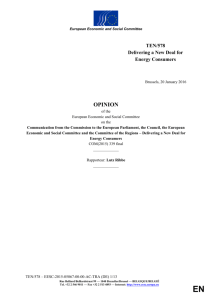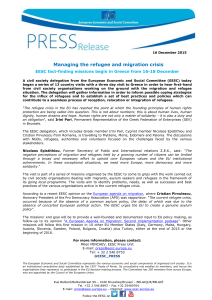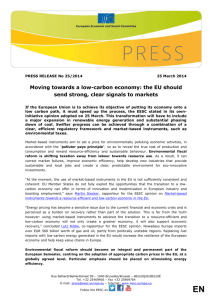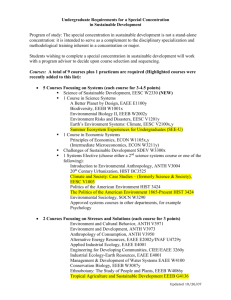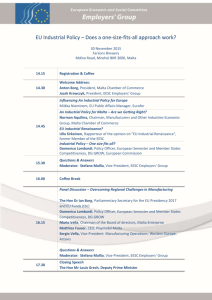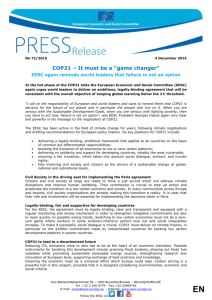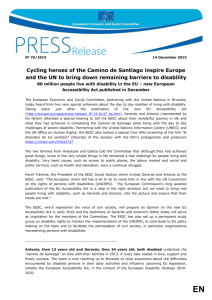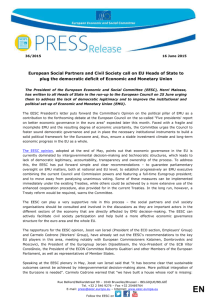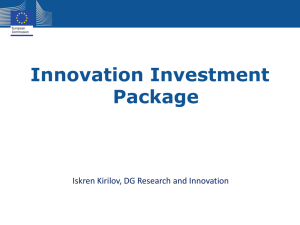Delivering a New Deal for Energy Consumers
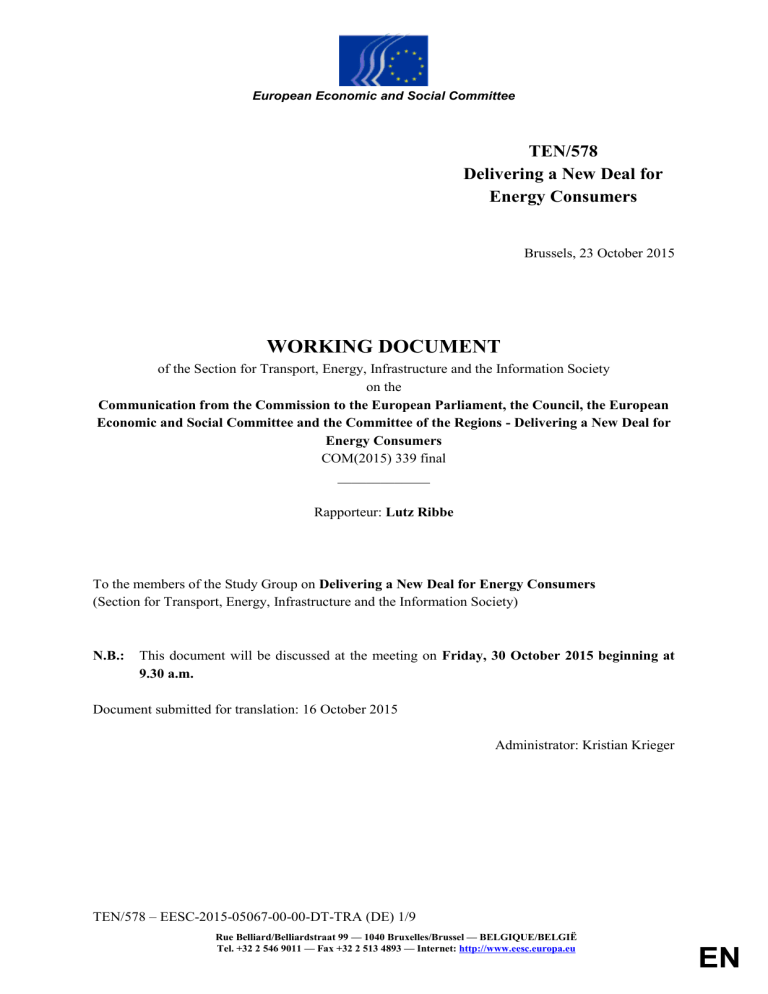
European Economic and Social Committee
TEN/578
Delivering a New Deal for
Energy Consumers
Brussels, 23 October 2015
WORKING DOCUMENT
of the Section for Transport, Energy, Infrastructure and the Information Society on the
Communication from the Commission to the European Parliament, the Council, the European
Economic and Social Committee and the Committee of the Regions - Delivering a New Deal for
Energy Consumers
COM(2015) 339 final
_____________
Rapporteur: Lutz Ribbe
To the members of the Study Group on Delivering a New Deal for Energy Consumers
(Section for Transport, Energy, Infrastructure and the Information Society)
N.B.: This document will be discussed at the meeting on Friday, 30 October 2015 beginning at
9.30 a.m.
Document submitted for translation: 16 October 2015
Administrator: Kristian Krieger
TEN/578 – EESC-2015-05067-00-00-DT-TRA (DE) 1/9
Rue Belliard/Belliardstraat 99 — 1040 Bruxelles/Brussel — BELGIQUE/BELGIË
Tel. +32 2 546 9011 — Fax +32 2 513 4893 — Internet: http://www.eesc.europa.eu
EN
Study Group:
Delivering a New Deal for
Energy Consumers
President:
Rapporteur:
Members:
Marian Krzaklewski (PL-II)
Lutz Ribbe (DE-III)
Mr/Ms
Curtis (UK-II)
Danev (BG-I)
Fatovic (IT-II)
Hernández-Bataller (ES-III)
Kattnig (AT-II)
Kekeleki (EL-III)
Manoliu (RO-I)
Strautmanis (LV-I)
Thomaes (BE-I)
Watson (UK-III)
Experts:
Marco Krasser (for the rapporteur)
TEN/578 – EESC-2015-05067-00-00-DT-TRA (DE) 2/9
On 15 July 2015, the European Commission decided to consult the European Economic and Social
Committee, under Article 304 of the Treaty on the Functioning of the European Union, on the
Communication from the Commission to the European Parliament, the Council, the
European Economic and Social Committee and the Committee of the Regions –
Delivering a New Deal for Energy Consumers
COM(2015) 339 final.
The Section for Transport, Energy, Infrastructure and the Information Society, which was responsible for preparing the Committee's work on the subject, adopted its opinion on ….
At its… plenary session (meeting of…), the European Economic and Social Committee adopted the following opinion by … votes to … with ... abstentions:
*
* *
1. Conclusions and recommendations
2.
Introduction (Gist of the Commission communication)
2.1
The Energy Union Strategic Framework
1
sets out the vision of an Energy Union "with citizens at its core, where citizens take ownership of the energy transition, benefit from new technologies to reduce their bills, participate actively in the market, and where vulnerable consumers are protected".
2.2
While the energy sector in Europe has been transformed in recent years, consumers, i.e. private households, businesses and industry, have been and continue to be prevented from reaping the full benefits of the current transition in the energy sector, i.e. controlling their energy consumption and reducing their energy bills. The factors causing this include:
the lack of appropriate information on costs and consumption, or limited transparency in offers,
the increasing proportion of network charges, taxes and particularly levies in final household electricity bills;
insufficient competition in many retail energy markets, a lack of reward for active participation and difficulties in switching;
insufficiently developed markets for residential energy services and demand response;
obstacles to self-generation and self-consumption;
1
COM(2015) 80 final.
TEN/578 – EESC-2015-05067-00-00-DT-TRA (DE) 3/9
unequal access to information and high barriers to entry for new competitors, which slow down the adoption of available advanced technologies and practices (smart metering, smart appliances, distributed energy sources and energy efficiency improvements).
2.3
The new electricity market design
2
, the use of new technologies, as well as new and innovative energy service companies are supposed to enable all consumers to participate fully in the energy transition with a view to better managing their consumption through energyefficient solutions and thereby saving money and reducing overall energy consumption.
2.4
At the same time, the role of the consumer is also set to change. Not only will consumers be able to respond better and more flexibly to electricity supplies and services, they will also be able to take on an active role as constructive energy producers.
2.5
The Commission talks about a "three-pillar strategy" consisting of a) consumer empowerment, b) technical innovations in the area of smart homes and networks, with c) special attention given to data management and data protection and which is due to be implemented through a ten-point action plan.
3.
General comments
3.1
The EESC expressly welcomes the Commission's analysis and firmly supports its proposals.
These appear to be well suited to implementing the objectives set (including reducing energy consumption through increased energy efficiency, switching energy production to clean energy sources, adapting consumption more effectively to greater fluctuations in energy output in the future, reducing the strain on the grid, increasing the number of players) in a way that is transparent and cost-effective for the consumer.
3.2
However, giving consumers more rights and opportunities also means making it clear to them that they too have a responsibility and must accept the need for adaptation. The stability and control of systems, transparency and the exchange of data are being redefined and require fundamental changes vis-à-vis the current situation.
3.3
The Communication makes it very clear that – aside from access to information - the real key factor for consumer decision-making is price, in particular the final price that is actually paid.
Whilst there is now much greater awareness of climate change issues and a positive attitude towards renewables amongst the public, it is primarily price which determines whether or not energy is saved, whether energy efficiency measures are implemented and whether environmentally-friendly energy sources are used.
2
See TEN/577 "Launching the public consultation process on a new energy market design".
TEN/578 – EESC-2015-05067-00-00-DT-TRA (DE) 4/9
3.4
It is right and important to recognise and support local supply and to promote the involvement of local market participants, partly in order to be able to offer real prices determined at the point of consumption, rather than at the point of production. What is needed is competition for the most efficient system. This goes beyond production and marketing.
3.5
In working towards this, great attention should be paid to the user-friendliness of systems.
They must be simple and transparent and must not under any circumstances overwhelm the consumer.
3.6
First of all, however, it will be necessary to establish a unified European framework, through which all costs associated with energy production are fully incorporated into the energy price, particularly external costs. While this is not the subject of the Commission communication, the EESC feels it is important to once again draw attention to this as much still remains to be done within the EU. Market regulation, however transparent, flexible and open, cannot compensate for incorrect price signals resulting from direct or indirect subsidies for particular energy sources.
4.
Pillar 1: Empowering consumers to act
4.1
The role of the consumer in the energy sector will change profoundly in the years to come. It is therefore entirely appropriate that the greater part of the Commission communication is devoted to this section. This is not simply a matter of technical and commercial law-related issues, but rather of fundamental structural changes which will lead to more democratic energy processes.
4.2
Enabling consumers to better manage their consumption independently with a view, among other things, to saving money, requires first and foremost that the technical conditions be met, in addition to better information. Situations where individual consumption is not or cannot be determined (and therefore billed) should be remedied as quickly as possible. Where new meters need to be installed, these should automatically be "smart meters". Consumption data should be improved quickly in line with the Commission’s plans, which also requires that the approximately 28% of consumers who will probably still be without access to "smart meters" after 2020 be given the right to apply for one.
4.3
In order to ensure a swift up-take of smart meters, the process must first of all be designed in a way that is cost-neutral for the consumer. Unified frameworks on data protection and communication protocols must be established for manufacturers (investment security). One possibility would be to allocate these costs to networks (stability condition).
4.4
Nowadays, a number of options are already available to consumers looking for cheaper supply on existing markets. The Commission’s statement that "making the switch needs to be technically easy, quick and reliable" should be self-evident in a Europe that was created to
TEN/578 – EESC-2015-05067-00-00-DT-TRA (DE) 5/9
promote the free movement of goods.
Therefore, the removal of switching fees and penalties should not " be considered ", but carried out!
4.5
Although switching supplier is an important tool for consumers, the EESC questions whether it is possible to determine how well competition is functioning based solely on the switching rate and prices. Customer satisfaction, local links and service at local level are already an increasingly important factor when choosing a supplier, as is the local availability of representatives of the supplier. Users are not only concerned about how their electricity is produced, but also where and by whom. There will therefore be competition both in terms of price and quality. If network costs and production costs are transparent, electricity that was marginally more expensive to produce but which has lower transport costs could on balance still end up being cheaper. However, this requires distance-based pricing in the network cost component.
4.6
The Committee agrees with the Commission that social policy objectives cannot be achieved through state-controlled or state-regulated energy prices.
4.7
The EESC believes that the statements relating to "demand response", "self-generation and self-consumption" and "increasing consumer participation through intermediation and collective schemes" are key as this opens up entirely new developments.
4.8
Demand response
4.8.1
The figures quoted in the Commission document relating to the success of existing demand response, e.g. through dynamic pricing (in energy supply agreements) and flexible, automated demand response systems provide striking evidence for the statement that "energy efficiency and demand response are often better options for balancing supply and demand than building or keeping in operation more power plants or network lines".
4.8.2
There will be active participation of end-users in the medium term only if the benefits of flexible tariffs offset the necessary investment costs within a reasonable time-frame. Price signals must therefore be correct, i.e. periods of high energy supply and lower demand (e.g. during windy or sunny periods) or of high demand and reduced supply must be reflected in selectable end-user prices.
4.8.3
The network-related technical requirements for engaging in active demand response (e.g. smart meters) should be understood and financed as part of grid development. Where appropriate, consideration could also be giving to incentives to encourage end-users to upgrade their consumer appliances.
TEN/578 – EESC-2015-05067-00-00-DT-TRA (DE) 6/9
4.9
Self-generation and consumption
4.9.1
Appropriate demand response systems could be used by consumers to do more than just adapt their energy consumption. As the Commission quite rightly points out, "the combination of decentralised generation and storage options with demand side flexibility can further enable consumers to become their own suppliers and managers for (a part of) their energy needs, becoming producers and consumers and reduce their energy bills".
4.9.2
However, this will only be possible if there is a genuinely new market design tailored to the formal objectives and no attempt is made to simply transform the existing system so that the new energies can be incorporated into it
3
.
4.9.3
In its communication the Commission sets out other advantages of decentralised generation of renewable energy, including being able to reduce grid losses and congestion and thereby save on network costs in the long term.
4.9.4
The detailed description of the benefits of this new approach in the working document
4
which accompanies the communication shows that this "prosumer approach" is more than merely a useful complement to the "centralised generation sources". This is about the public's freedom to choose to play an active role in the energy system of the future through self-generation, self-consumption and storage.
4.10
Consumer participation through intermediation and collective schemes
4.10.1
The Commission also talks about "collective schemes and community initiatives" that "have been emerging with increasing frequency in a number of Member States. More and more consumers engage in collective self-generation and cooperative schemes to better manage their energy consumption. This innovation by consumers leads to innovation for consumers and opens up new business models. Energy services companies, aggregators, brokers, data handling companies, other intermediary companies and frequently also consumer organisations are emerging to help consumers achieve better energy deals while relieving them from administrative procedures and cumbersome research. ... This also opens new opportunities for local communities and authorities whose regional and local energy initiatives can provide a valuable link between decision-makers, citizens and innovators at the local level".
4.10.2
The study carried out by the EESC on civic energy
5 — dealing precisely with this "prosumer approach" – highlights that a range of additional benefits can also be cited (e.g. increased
3
The EESC points in this connection to its opinion on Launching the public consultation process on a new energy market design
(TEN/577).
4
SWD(2015) 141, 15.7.2015.
5
See the EESC study on Changing the future of energy: EESC study on the role of civil society in the implementation of the EU
Renewable Energy Directive (EESC-2014-04780-00-04-TCD-TRA (EN).
TEN/578 – EESC-2015-05067-00-00-DT-TRA (DE) 7/9
public support for new plants, development opportunities for regional economies). In all
Member States visited, the EESC identified an extremely high level of willingness on the part of civil society to actively support private sector and/or community models and/or to implement these themselves. However, these initiatives often fail to due to legal requirements, bureaucracy or as a result of other intended or unintended discrimination.
4.10.3
One example: individuals who collectively operate a civic wind turbine are often unable to directly access and use their electricity and instead must place it on the market via distributors and subsequently buy it back themselves. This is not what the EESC understands by "active market participation".
4.10.4
In the introduction to the communication, the Commission states that obstacles "preventing consumers from self-generation and self-consumption" are an issue that needs to be addressed. Unfortunately, however, the document does not describe in concrete terms where and how these obstacles arise and what must be done to eliminate them. The Committee therefore calls on the Commission to draw up a specific paper to be included in the consultation process, building on SWD(2015) 141 and describing what intended or unintended disadvantages are encountered by prosumer approaches, what bureaucratic hurdles exist and how existing discrimination is to be eliminated.
4.10.5
The discussion on the role of intermediaries should also look at the independence of large distributors. In order to preserve this, a further discussion on the business models of intermediaries and the question as to who their clients are would be useful.
4.10.6
This also means that the Commission should carry out a self-critical analysis of whether or not its own requirements, e.g. on the promotion of renewables focusing on auction systems, are genuinely beneficial to the approach.
5.
Pillar 2: Smart homes and networks
5.1
Another aspect of including local activities involves the networking of other levels.
Networked devices become smart homes, which become smart buildings, which in turn become active network components. Therefore, it is necessary to introduce appropriate framework regulations and conditions and to plan the communication and data protection aspects of this networking process in advance.
5.2
We should aim for a speedy, uniform and comprehensive roll-out of smart meters. This will require the harmonisation and standardisation of both legal and technical requirements.
TEN/578 – EESC-2015-05067-00-00-DT-TRA (DE) 8/9
6.
Pillar 3: Data management and data protection
6.1
Standardised, reliable data protection directives are the foundation of the rapid, future-proof roll-out of modern communication systems. The following must be specified:
How the data must be encrypted.
Who owns the data.
What data are required for optimised operation.
Where and for how long the data may be stored.
_____________
TEN/578 – EESC-2015-05067-00-00-DT-TRA (DE) 9/9
